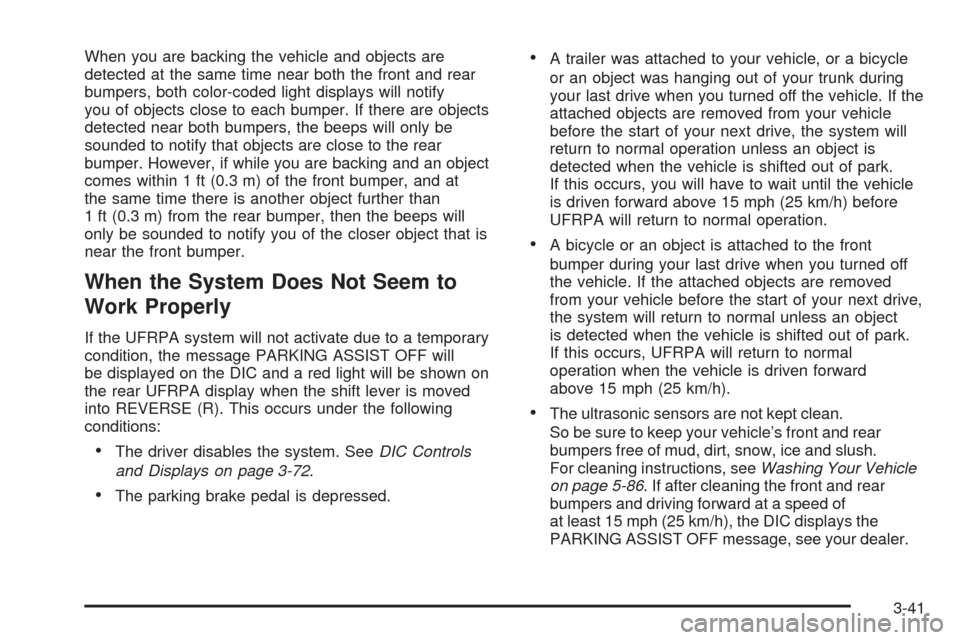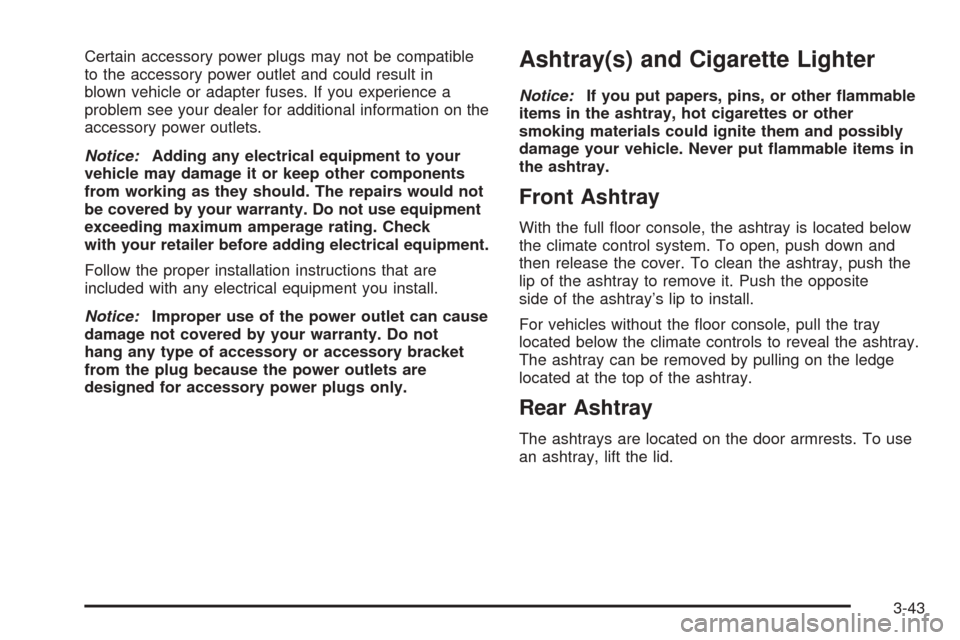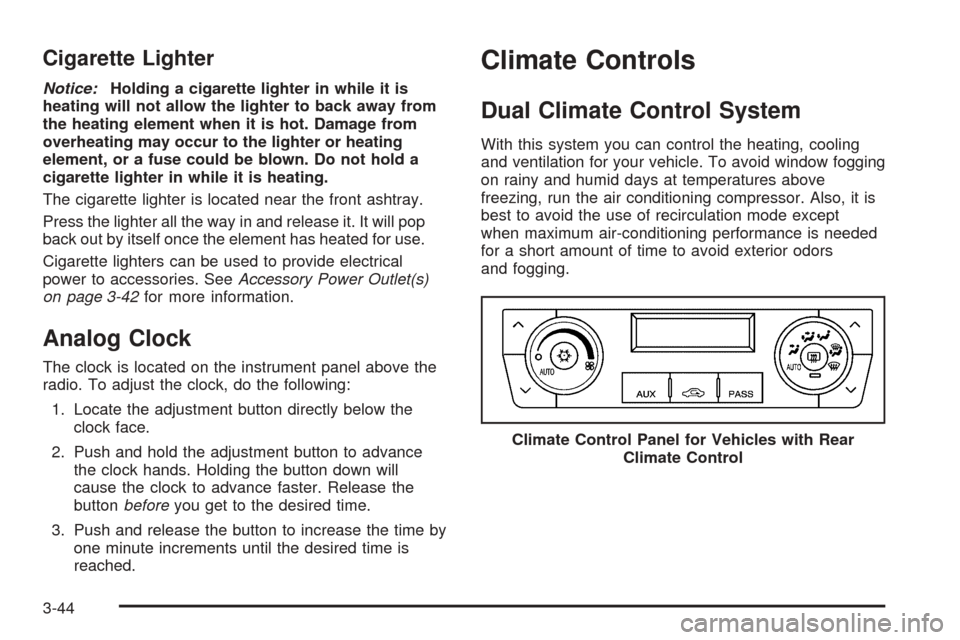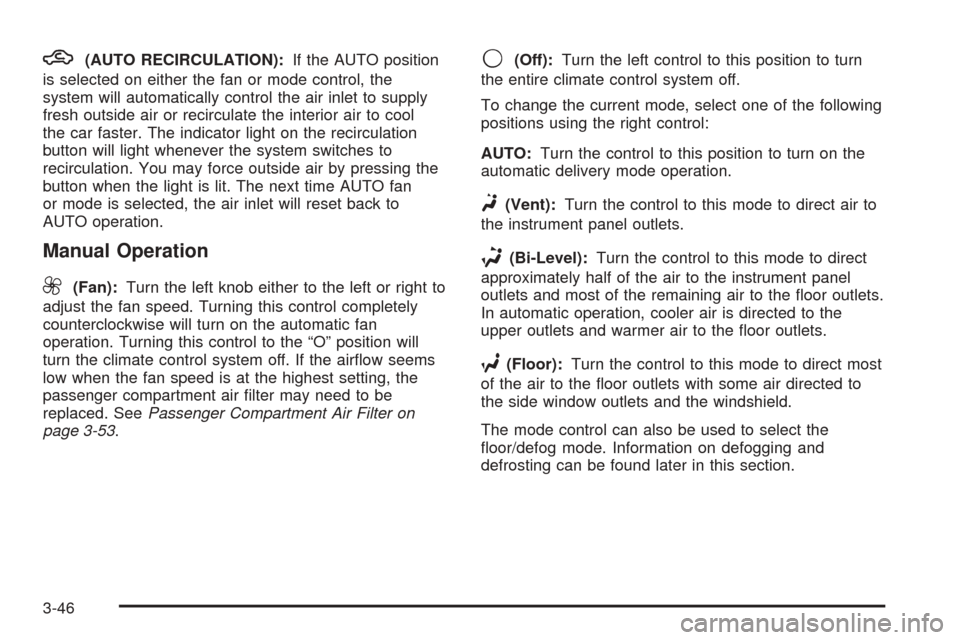CADILLAC DTS 2006 1.G Owners Manual
Manufacturer: CADILLAC, Model Year: 2006, Model line: DTS, Model: CADILLAC DTS 2006 1.GPages: 450, PDF Size: 2.55 MB
Page 171 of 450

The front display is located on top of the instrument
panel to the right of the driver. The rear display is
located near the rear window and can be seen by
looking over your right shoulder. The rear display has
three color-coded lights. The front display will have
either three or six lights depending on whether
your vehicle is equipped with Adaptive Cruise Control
(ACC). If your vehicle has ACC, it will have three lights
along with the ACC lights. If your vehicle does not
have ACC, it will have six UFRPA lights.The UFRPA lights are used to provide distance and
system information, along with beeps played out either
the front or rear speakers. For objects detected near
the front bumper, high-toned beeps will be played
out the front speakers. For objects detected near the
rear bumper, low-toned beeps will be played out the
rear speakers.
How the System Works
When the vehicle is started, the front display will
brie�y illuminate to let you know the display is
operating correctly. When the shift lever is moved into
REVERSE (R), the rear display will brie�y illuminate
to let you know the display is operating correctly.
UFRPA comes on automatically when the shift lever is
moved out of PARK (P). The system does not work
at a forward speed greater than 5 mph (8 km/h), so
the front display indicators are turned off. The system
also does not work at a reverse speed greater than
5 mph (8 km/h). To remind you of this, the red light on
the rear display will �ash.
The system can be disabled using the Driver Information
Center (DIC). SeeDIC Controls and Displays on
page 3-72. Front Parking Assist
Display
Rear Parking Assist
Display
3-39
Page 172 of 450

How the System Works when
Moving Forward
When moving forward, the system detects objects only
near the front bumper.
If an object is detected at a forward speed of less
than 5 mph (8 km/h), or if you are already within a
4 ft (1.2 m) distance to a detected object when
UFRPA �rst comes on, the following describes what
will occur according to your distance from an object
located in front of the vehicle:
At distances between 40 inches (1 m) and
4 ft (1.2 m), two amber lights will be lit. If you
have Adaptive Cruise Control, a single amber
light will be lit.
At distances between 23 inches (0.6 m) and
40 inches (1 m), four amber lights will be lit.
If you have Adaptive Cruise Control, two amber
lights will be lit.
At distances between 12 inches (0.3 m) and
23 inches (0.6 m), all six lights (four amber lights/
two red lights) will be lit. If you have Adaptive Cruise
Control, all three lights (amber/amber/red) will be lit.
At distances less than 12 inches (0.3 m), a chime will
sound for a short time and all six lights (four amber
lights/two red lights) will be lit and �ashing. If you
have Adaptive Cruise Control, a chime will sound for
a short time and all three lights (two amber lights/
one red light) will be lit and �ashing.
How the System Works when Backing
When backing, UFRPA detects objects close to the
front and rear bumpers. The �rst time an object
is detected a single chime will sound. If an object is
detected at a REVERSE (R) speed of less than 5 mph
(8 km/h), or if you are already within an 8 ft (2.5 m)
distance to a detected object when the system
�rst comes on, the following describes what will occur
according to your distance from an object located behind
the vehicle:
At distances between 40 inches (1 m) and
8 ft (2.5 m), a single amber light will be lit.
At distances between 23 inches (0.6 m) and
40 inches (1 m), both amber lights will be lit.
At distances between 12 inches (0.3 m) and
23 inches (0.6 m), all three lights (amber/amber/red)
will be lit.
At distances less than 12 inches (0.3 m), a chime
will sound for a short time and all three lights
(amber/amber/red) will be lit and �ashing.
3-40
Page 173 of 450

When you are backing the vehicle and objects are
detected at the same time near both the front and rear
bumpers, both color-coded light displays will notify
you of objects close to each bumper. If there are objects
detected near both bumpers, the beeps will only be
sounded to notify that objects are close to the rear
bumper. However, if while you are backing and an object
comes within 1 ft (0.3 m) of the front bumper, and at
the same time there is another object further than
1 ft (0.3 m) from the rear bumper, then the beeps will
only be sounded to notify you of the closer object that is
near the front bumper.
When the System Does Not Seem to
Work Properly
If the UFRPA system will not activate due to a temporary
condition, the message PARKING ASSIST OFF will
be displayed on the DIC and a red light will be shown on
the rear UFRPA display when the shift lever is moved
into REVERSE (R). This occurs under the following
conditions:
The driver disables the system. SeeDIC Controls
and Displays on page 3-72.
The parking brake pedal is depressed.
A trailer was attached to your vehicle, or a bicycle
or an object was hanging out of your trunk during
your last drive when you turned off the vehicle. If the
attached objects are removed from your vehicle
before the start of your next drive, the system will
return to normal operation unless an object is
detected when the vehicle is shifted out of park.
If this occurs, you will have to wait until the vehicle
is driven forward above 15 mph (25 km/h) before
UFRPA will return to normal operation.
A bicycle or an object is attached to the front
bumper during your last drive when you turned off
the vehicle. If the attached objects are removed
from your vehicle before the start of your next drive,
the system will return to normal unless an object
is detected when the vehicle is shifted out of park.
If this occurs, UFRPA will return to normal
operation when the vehicle is driven forward
above 15 mph (25 km/h).
The ultrasonic sensors are not kept clean.
So be sure to keep your vehicle’s front and rear
bumpers free of mud, dirt, snow, ice and slush.
For cleaning instructions, seeWashing Your Vehicle
on page 5-86. If after cleaning the front and rear
bumpers and driving forward at a speed of
at least 15 mph (25 km/h), the DIC displays the
PARKING ASSIST OFF message, see your dealer.
3-41
Page 174 of 450

Other conditions that may affect system performance
include vibrations from a jackhammer or the
compression of air brakes on a very large truck or
other mechanical devices that interfere with UFRPA
performance.
When UFRPA is disabled without driver action and
the driver attempts to turn UFRPA back on using the
Driver Information Center (DIC), the PARKING
ASSIST ON option will not be selectable if the
necessary conditions stated above for normal system
operation are not met.
As always, drivers should use care when backing up a
vehicle. Always look behind you, being sure to check
for other vehicles, obstructions and blind spots.
For Driver Information Center messages related to
UFRPA, seeDIC Warnings and Messages on
page 3-76.
If the bumper is damaged, your UFRPA system may
not work properly. Take the vehicle to your dealer
to repair the system.
Accessory Power Outlet(s)
Your vehicle is equipped with accessory power outlets.
The outlets can be used to plug in electrical equipment
such as a cellular telephone, CB radio, etc.
If your vehicle has a stationary center console, the
power outlet is located inside the lower storage area.
There are outlets also on the right front lower part of the
driver’s seat and in the lower storage bin. SeeCenter
Console Storage Area on page 2-50.
There are two accessory power outlets in the rear
seat area located on the door armrests next to the
ashtrays.
Your vehicle may have a small cap that must be
removed to access the accessory power outlet. If it
does, when not using the outlet be sure to cover it with
the protective cap.
The accessory power outlet can be used at any time.
Notice:Leaving electrical equipment on for
extended periods will drain the battery. Always turn
off electrical equipment when not in use and do
not plug in equipment that exceeds the maximum
amperage rating.
3-42
Page 175 of 450

Certain accessory power plugs may not be compatible
to the accessory power outlet and could result in
blown vehicle or adapter fuses. If you experience a
problem see your dealer for additional information on the
accessory power outlets.
Notice:Adding any electrical equipment to your
vehicle may damage it or keep other components
from working as they should. The repairs would not
be covered by your warranty. Do not use equipment
exceeding maximum amperage rating. Check
with your retailer before adding electrical equipment.
Follow the proper installation instructions that are
included with any electrical equipment you install.
Notice:Improper use of the power outlet can cause
damage not covered by your warranty. Do not
hang any type of accessory or accessory bracket
from the plug because the power outlets are
designed for accessory power plugs only.Ashtray(s) and Cigarette Lighter
Notice:If you put papers, pins, or other �ammable
items in the ashtray, hot cigarettes or other
smoking materials could ignite them and possibly
damage your vehicle. Never put �ammable items in
the ashtray.
Front Ashtray
With the full �oor console, the ashtray is located below
the climate control system. To open, push down and
then release the cover. To clean the ashtray, push the
lip of the ashtray to remove it. Push the opposite
side of the ashtray’s lip to install.
For vehicles without the �oor console, pull the tray
located below the climate controls to reveal the ashtray.
The ashtray can be removed by pulling on the ledge
located at the top of the ashtray.
Rear Ashtray
The ashtrays are located on the door armrests. To use
an ashtray, lift the lid.
3-43
Page 176 of 450

Cigarette Lighter
Notice:Holding a cigarette lighter in while it is
heating will not allow the lighter to back away from
the heating element when it is hot. Damage from
overheating may occur to the lighter or heating
element, or a fuse could be blown. Do not hold a
cigarette lighter in while it is heating.
The cigarette lighter is located near the front ashtray.
Press the lighter all the way in and release it. It will pop
back out by itself once the element has heated for use.
Cigarette lighters can be used to provide electrical
power to accessories. SeeAccessory Power Outlet(s)
on page 3-42for more information.
Analog Clock
The clock is located on the instrument panel above the
radio. To adjust the clock, do the following:
1. Locate the adjustment button directly below the
clock face.
2. Push and hold the adjustment button to advance
the clock hands. Holding the button down will
cause the clock to advance faster. Release the
buttonbeforeyou get to the desired time.
3. Push and release the button to increase the time by
one minute increments until the desired time is
reached.
Climate Controls
Dual Climate Control System
With this system you can control the heating, cooling
and ventilation for your vehicle. To avoid window fogging
on rainy and humid days at temperatures above
freezing, run the air conditioning compressor. Also, it is
best to avoid the use of recirculation mode except
when maximum air-conditioning performance is needed
for a short amount of time to avoid exterior odors
and fogging.
Climate Control Panel for Vehicles with Rear
Climate Control
3-44
Page 177 of 450

Automatic Operation
AUTO9(Automatic Fan):When this position is
selected on the fan control, the system will adjust the fan
speed. If the OnStar
®system is activated when this
position is selected, the climate control fan speed
will lower.
AUTO (Automatic Mode):
1. Turn the fan control to the AUTO position.
2. Turn the mode control to the AUTO position.
3. Adjust the temperature to a comfortable setting
between 68°F (21°C) and 78°F (26°C).
Choosing the coldest or warmest temperature
setting will not cause the system to heat or cool any
faster. In cold weather, the system will start at
reduced fan speeds to avoid blowing cold air into
your vehicle until warmer air is available. The
system will start out blowing air at the �oor but may
change modes automatically as the vehicle
warms up to maintain the chosen temperature
setting. The length of time needed to warm
the interior will depend on the outside temperature
and temperature of the vehicle.
4. Wait 20 to 30 minutes for the system to stabilize in
order for the system to regulate automatically. Then
adjust the temperature as necessary to �nd your
comfort setting.Do not cover the solar sensor located in the center of
the instrument panel near the windshield. For more
information on the solar sensor, see “Sensors” later in
this section.
After your vehicle is started, the display will show the
interior temperature settings and the outside
temperature.
If the AUTO position is selected on the fan or mode
control, the system will automatically control the
air conditioning compressor. The A/C compressor will
run automatically even at cool outside temperatures
in order to dehumidify the air. The A/C indicator light
will be lit when the system is operating automatically,
even at near freezing outside temperatures. Press
the A/C button on the fan control to turn off the A/C.
For improved window clearing performance in defog
or defrost modes, the A/C compressor will run
automatically in damp cool conditions.
3-45
Page 178 of 450

h(AUTO RECIRCULATION):If the AUTO position
is selected on either the fan or mode control, the
system will automatically control the air inlet to supply
fresh outside air or recirculate the interior air to cool
the car faster. The indicator light on the recirculation
button will light whenever the system switches to
recirculation. You may force outside air by pressing the
button when the light is lit. The next time AUTO fan
or mode is selected, the air inlet will reset back to
AUTO operation.
Manual Operation
9(Fan):Turn the left knob either to the left or right to
adjust the fan speed. Turning this control completely
counterclockwise will turn on the automatic fan
operation. Turning this control to the “O” position will
turn the climate control system off. If the air�ow seems
low when the fan speed is at the highest setting, the
passenger compartment air �lter may need to be
replaced. SeePassenger Compartment Air Filter on
page 3-53.
9(Off):Turn the left control to this position to turn
the entire climate control system off.
To change the current mode, select one of the following
positions using the right control:
AUTO:Turn the control to this position to turn on the
automatic delivery mode operation.
F(Vent):Turn the control to this mode to direct air to
the instrument panel outlets.
*(Bi-Level):Turn the control to this mode to direct
approximately half of the air to the instrument panel
outlets and most of the remaining air to the �oor outlets.
In automatic operation, cooler air is directed to the
upper outlets and warmer air to the �oor outlets.
7(Floor):Turn the control to this mode to direct most
of the air to the �oor outlets with some air directed to
the side window outlets and the windshield.
The mode control can also be used to select the
�oor/defog mode. Information on defogging and
defrosting can be found later in this section.
3-46
Page 179 of 450

?(Recirculation):Press this button to keep outside
air from coming in the vehicle. It can be used to
prevent outside air and odors from entering your vehicle
or to help cool the air inside your vehicle more quickly.
Press this button to turn the recirculation mode on or off.
When the button is pressed, an indicator light will
come on.
«ª(Driver’s Temperature Controls):Press these
buttons next to the fan control to manually increase
or decrease the temperature inside your vehicle.
«ª(Passenger’s Temperature Controls):Press
these buttons next to the mode control to manually
increase or decrease the temperature for the front
passenger. If the passenger’s climate control system
is off, pressing one of these buttons will turn it on.
PASS (Passenger’s Climate Control):Press
this button to turn the passenger’s climate control
systems on or off. The temperature selected by the
front passenger will also control the rear system
air temperature unless the rear seat passengers select
their own comfort setting.If the PASS button is pressed to turn the Passenger
temperature setting off, the driver’s temperature
knob will control the temperature for the entire vehicle.
AUX:Press this button to turn the rear climate
control fan on for automatic operation. After the AUX
button is pressed, the indicator light will come on.
Press the button again to turn the auxiliary fan off.
#(Air Conditioning):Press this button to override
the automatic system and turn the air-conditioning
system on or off. When in AUTO, the air-conditioning
compressor will come on automatically, as necessary.
The air-conditioning system removes moisture from
the air, so you may notice a small amount of water
dripping underneath your vehicle while idling or after
turning off the engine. This is normal.
3-47
Page 180 of 450

Sensors
The solar sensor, located in the defrost grille, middle of
the instrument panel, monitors the solar radiation.
Do not cover the solar sensor or the system will not
work properly.There is also an interior temperature sensor located
next to the steering wheel that measures the
temperature of the air inside your vehicle.
There is also an exterior temperature sensor located
behind the front grille. This sensor reads the outside air
temperature and helps maintain the temperature inside
the vehicle. Any cover on the front of the vehicle could
cause a false reading in the displayed temperature.
3-48